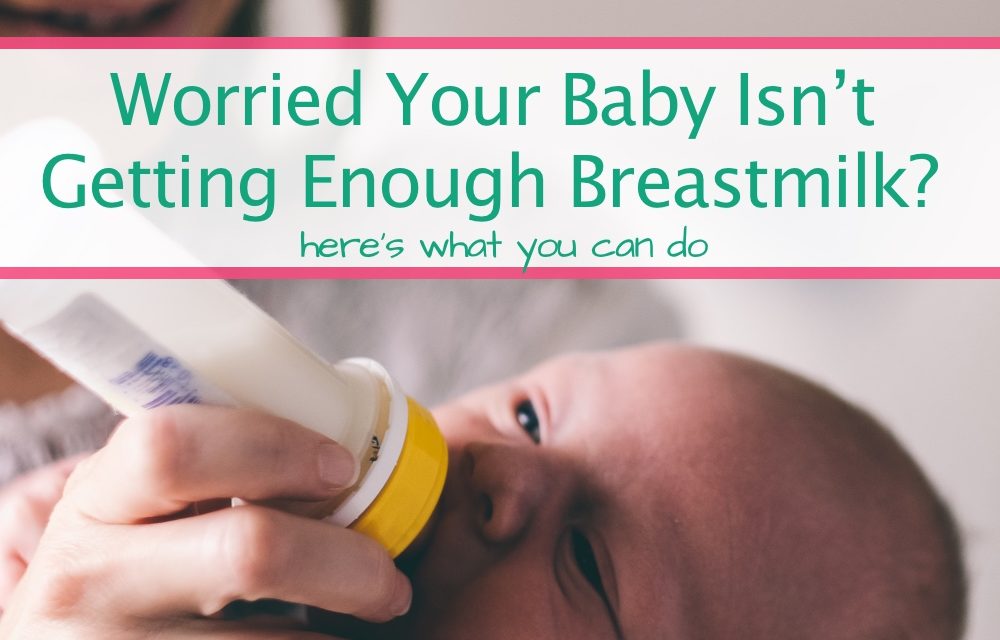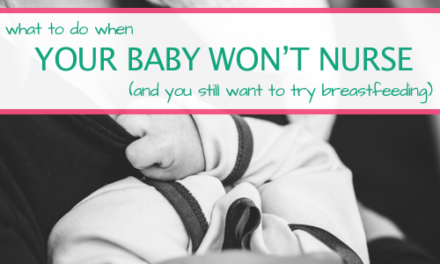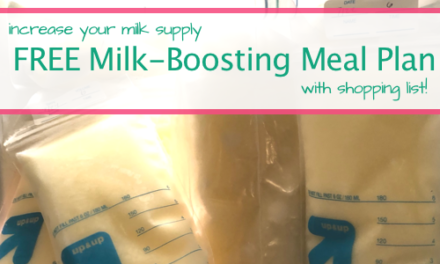Worrying about whether your baby is getting enough breastmilk is a big concern for nursing moms.
In the first few weeks when Squiggles wasn’t really breastfeeding it was easy—well, despite the not really breastfeeding part—because I had a guideline to follow: 25-32 ounces of breastmilk or formula a day, or 3-4 oz from a bottle 8 times a day.
Easy-peasy.
But when my baby FINALLY got the hang of nursing I was always on edge, worrying about whether she got enough breastmilk and always assuming I would have to follow up each nursing session with a bottle.
Yep, “is my baby getting enough breastmilk?” is a concern of SO MANY breastfeeding moms. We wonder if they are getting enough milk at 3 months, at 5 months, or getting enough milk at night, or enough from each breast…
And while your friends or your doctor or your mom might tell you to stop worrying, I’m here to tell you IT’S OKAY.
This page probably contains affiliate links—you can read more about our affiliate policy here.
Squiggles was an 11 pound baby, so even though she lost more than 10% of her birth weight, no one—except me and my lactation consultant—was concerned. We had so much trouble nursing in the beginning, but in the days after leaving the hospital she was actually breastfeeding for 20 minutes each time and falling asleep after each feeding!
I thought we had figured this whole thing out. I was wrong.
Turns out she was working so hard to get the milk out that she was burning way too many calories trying to eat. She was falling asleep because she was exhausted, not because she was full.
Eventually, Squiggles did get strong enough and became a master nurser, but I’m so glad I was worried and constantly looking for signs if my baby was getting enough breastmilk.
You are only trying to do what’s best for your child, but sometimes (okay like most times!) it’s not easy.
If you find yourself constantly worrying about whether your baby is getting enough milk, try some of these strategies to help give you peace of mind.
Meet with a Lactation Consultant
I met with a lactation consultant twice a week for the first 8 weeks of Squiggles’ life. It was a lot—and I definitely recommend seeing a lactation consultant if you have had problems nursing like we did.
Related: What To Do When Your Baby Won’t Nurse
Here’s what happens during a typical lactation appointment: you and baby come hungry (baby does that is), baby gets a baseline weigh, then you nurse on one side, weigh again, nurse on the other breast, do a final weigh, and then (hopefully) there is time for you to pump and talk with the lactation consultant about your output.
The before and after weigh-ins are particularly helpful here, because these will tell you how many ounces (or milliliters in the early days!) baby is getting.
You’ll also talk with the lactation consultant about how much milk baby should be getting, which is especially important in those first few weeks if baby has not returned to her birth weight. Our consultant entered Squiggles’ measurements into a computer and gave us a chart to track this each time we came in.
Not all lactation clinics will allow time for pumping, but it’s easy when they do. I was already kind of a pro pumper by the end of my first week of being a mom, but for some you might have no idea where to begin and it’s nice to learn some tips the consultant.
A lot of hospitals or lactation clinics may actually have free weigh-in times, so I definitely recommend going to a few of those if you don’t want to make an appointment.
Rent a Scale to Weigh Your Newborn Before and After Nursing
I still recommend seeing a lactation consultant first, but renting a newborn scale from the hospital or lactation clinic can help provide some relief if you just can’t tell if baby is getting enough milk.
Now, don’t rent a scale for weeks on end. Rent one for the weekend or just a few days – weigh baby before and after each nursing session to see how much breastmilk she is getting. If she’s getting within the normal range of 25-32 ounces and is gaining weight (about 1 ounce a day the first month), that’s amazing and it means you and baby are doing something right! If baby is eating less or is not getting enough and still not gaining weight that quickly—like mine did—make sure to talk to you doctor.
And don’t use these weigh-ins as an official monitoring of your baby’s weight. Leave that to your pediatrician.
Count Wet Diapers
5-7 wets and 3-4 dirties by day 4 is considered normal.
We kept a tally sheet next to the changing table because I could never remember, and chances are you won’t either, especially if dad or grandma is helping to change a few diapers during the day.
Counting diapers was also a hard one for me—I mean, how do you determine what constitutes a wet diaper? Using diapers with wetness indicators helped out a bunch, and we always counted a diaper as wet if the line was at least three-fourths of the way blue.
I still preferred doing the weigh-ins given how finicky those wet diapers can be, so as always, go with your gut mama.
Take a Nursing Break and Pump Instead
If baby is at least a month old and is able to take a bottle you could try a nursing break and pump instead for a day. This would help answer whether or not you are producing enough milk, and can also help you gauge how much baby tends to take.
This strategy has its downside too, along with counting wet diapers, because you just can’t really measure how much baby is taking from you because you aren’t nursing.
When I did this I would pump every time baby ate, so it was best to do this on the weekends when dad was around to help with feedings (if you don’t have a milk supply built up yet, pump first and then feed baby). I pumped for 20 minutes each time to maintain my supply. Breastfeeding Magazine has a great infographic how much much expressed breast milk babies need from newborn to 12 months.
Pay Attention to Baby’s Swallows
There’s a difference between comfort sucking and nutritive sucking. Nutritive sucks will result in swallows, which mean your baby is having an effective feeding. If you see movement alongside baby’s ear (or if the ear is wiggling) and temples, then those are nutritive sucks.
Most likely, you’ll be able to tell the difference pretty clearly. I thought Squiggles was nursing well at first because she stayed on for 10-15 minutes each side, but she wasn’t. When she finally started to nurse 8 weeks after birth, man those sucks were POW-ER-FUL.
If baby’s chin is dropping down long and slow, or baby is making small noises, those are swallows.
I hope trying out some of these strategies can help keep your mind at ease when it comes to worry if baby is getting enough milk when breastfeeding. You ultimately know your baby best so make sure to see your doctor if you have ANY concerns.
Worried about your milk supply? Check out this FREE Breast Milk-Boosting Meal Plan and Shopping List!








Trackbacks/Pingbacks